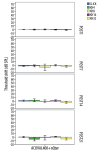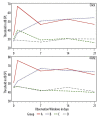A new oral otoprotective agent. Part 1: Electrophysiology data from protection against noise-induced hearing loss
- PMID: 22207104
- PMCID: PMC3560681
- DOI: 10.12659/msm.882180
A new oral otoprotective agent. Part 1: Electrophysiology data from protection against noise-induced hearing loss
Abstract
Background: Data from animal studies show that antioxidants can compensate against noise-induced stress and sensory hair cell death. The aim of this study was to evaluate the otoprotection efficacy of various versions of orally administered Acuval 400 against noise damage in a rat animal model.
Material/methods: Fifty-five Sprague Dawley rats were divided into 4 groups: A) noise-exposed animals; B) animals exposed to noise and treated with the Acuval; C) animals exposed to noise and treated with a combination of Coenzyme Q10 and Acuval; D) animals treated only with Acuval and Coenzyme Q10 and with no exposure to noise. All solutions were administered orally 5 times: 24 and 2 hrs prior to noise exposure, and then daily for 3 days. The auditory function was assessed by measuring auditory brainstem responses (ABR) in the range from 2 to 32 kHz at times =1, 7, 14 and 21 days after noise exposure.
Results: At low frequencies (click and 4 kHz) animals from both A and B groups showed significant threshold shifts in the majority of the tested frequencies and tested times. For the same frequencies, animals from group C presented threshold levels similar to those from group D. At frequencies ≥ 8 kHz the protective performance of the 2 Acuval groups is more clearly distinguished from the noise group A. At 32 kHz the 2 Acuval groups perform equally well in terms of otoprotection. Animals in Group D did not show any significant differences in the hearing threshold during the experiment.
Conclusions: The data of this study suggest that a solution containing Coenzyme Q10 and Acuval 400, administered orally, protects from noise-induced hearing loss.
Figures



Similar articles
-
Coenzyme Q10 plus Multivitamin Treatment Prevents Cisplatin Ototoxicity in Rats.PLoS One. 2016 Sep 15;11(9):e0162106. doi: 10.1371/journal.pone.0162106. eCollection 2016. PLoS One. 2016. PMID: 27632426 Free PMC article.
-
Novel oral multifunctional antioxidant prevents noise-induced hearing loss and hair cell loss.Hear Res. 2020 Mar 15;388:107880. doi: 10.1016/j.heares.2019.107880. Epub 2020 Jan 3. Hear Res. 2020. PMID: 31945692 Free PMC article.
-
The impact of biological sex on the response to noise and otoprotective therapies against acoustic injury in mice.Biol Sex Differ. 2018 Mar 12;9(1):12. doi: 10.1186/s13293-018-0171-0. Biol Sex Differ. 2018. PMID: 29530094 Free PMC article.
-
Effect of water-soluble coenzyme Q10 on noise-induced hearing loss in guinea pigs.Acta Otolaryngol. 2008 Oct;128(10):1071-6. doi: 10.1080/00016480801891694. Acta Otolaryngol. 2008. PMID: 18607964
-
Antioxidant Therapy as an Effective Strategy against Noise-Induced Hearing Loss: From Experimental Models to Clinic.Life (Basel). 2023 Apr 17;13(4):1035. doi: 10.3390/life13041035. Life (Basel). 2023. PMID: 37109564 Free PMC article. Review.
Cited by
-
Otoacoustic emissions before and after listening to music on a personal player.Med Sci Monit. 2014 Aug 13;20:1426-31. doi: 10.12659/MSM.890747. Med Sci Monit. 2014. PMID: 25116920 Free PMC article.
-
Otoprotectants: From Research to Clinical Application.Semin Hear. 2019 May;40(2):162-176. doi: 10.1055/s-0039-1684045. Epub 2019 Apr 26. Semin Hear. 2019. PMID: 31036993 Free PMC article. Review.
-
Pharmacological agents used for treatment and prevention in noise-induced hearing loss.Eur Arch Otorhinolaryngol. 2016 Dec;273(12):4089-4101. doi: 10.1007/s00405-016-3936-2. Epub 2016 Feb 16. Eur Arch Otorhinolaryngol. 2016. PMID: 26882913 Review.
-
Tinnitus and Neuropsychological Dysfunction in the Elderly: A Systematic Review on Possible Links.J Clin Med. 2021 Apr 27;10(9):1881. doi: 10.3390/jcm10091881. J Clin Med. 2021. PMID: 33925344 Free PMC article. Review.
-
Coenzyme Q10 plus Multivitamin Treatment Prevents Cisplatin Ototoxicity in Rats.PLoS One. 2016 Sep 15;11(9):e0162106. doi: 10.1371/journal.pone.0162106. eCollection 2016. PLoS One. 2016. PMID: 27632426 Free PMC article.
References
-
- Yamane H, Nakai Y, Takayama M, et al. Appearance of free radicals in the guinea pig inner after noise-induced acoustic trauma. Eur Arch Otorhinolaryngol. 1995;252:504–8. - PubMed
-
- Halliwell B, Gutteridge J. Free Radicals in Biology and Disease. Oxford: Oxford University Press; 1999.
-
- Ohinata Y, Miller JM, Altschuler RA, Schact J. Intense noise induces formation of vasoactive lipid peroxidation products in the cochlea. Brain Res. 2000a;878(1–2):163–73. - PubMed
-
- Ohlemiller KK, Dugan LL. Elevation of reactive oxygen species following ischemia-reperfusion in mouse cochlea observed in vivo. Audiol Neurootol. 1999;5:219–28. - PubMed
Publication types
MeSH terms
Substances
LinkOut - more resources
Full Text Sources
Other Literature Sources

